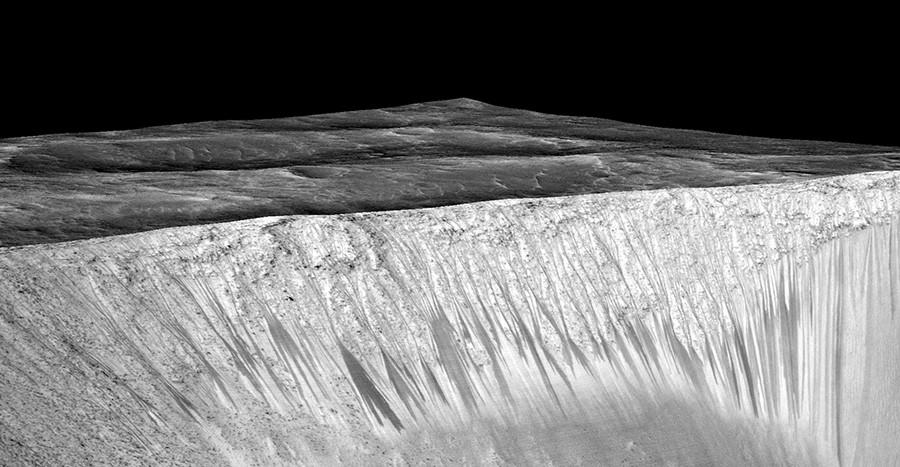Water on Mars: What Does This Mean for the Future?
The dark streaks here are hypothesized to be formed by flow of briny liquid water on Mars.
New things are found out about space every day, and recently the National Aeronautics and Space Administration (NASA) team made a discovery that has everyone in the world paying attention. On September 28th, 2015, NASA’s Mars Reconnaissance Orbiter (MRO) delivered images to NASA databases that suggests definite possibilities of water on Mars. The photos depict a scene with dark streaks that can only be explained by one thing: flowing water. In previous expeditions, frozen water lurking under the rocky surface of the Red Planet had been discovered, but flowing water on the surface is a new and exciting development for scientists studying the planet. By analyzing information brought from the world, scientists have discovered a mass of water that flows in the warmer months of Mars’s seasons.
Because of this huge new discovery, the possibility of sending a human to Mars is being talked about more and more. NASA says they are working to develop capabilities to send a team to space, and if all goes according to plan, humans should be on Mars by sometime in the 2030s.
Controversy has arisen, however, because the billions of dollars it takes to fund space exploration takes a serious cut out of government spending. Despite the critics, NASA is determined to further this expedition because of the greatness it could bring to our future. The possibilities are endless to what can become of the world if a trip to Mars is successful.
“It seems that the more we study Mars, the more we learn how life could be supported and where there are resources to support life in the future.” Michael Meyer, lead scientist for NASA’s Mars Exploration Program, said.
A major goal for NASA’s exploration program within the past decade has been finding life outside of our world. To do that, the team has been using a strategy they call “follow the water.” The discovery of water on Mars, the second closest planet to Earth (the first is Venus), marks a huge step for the program. Scientists are amazed by the possibility of alien life as close as Mars. If a form of life is found on the Red Planet, the secrets of life’s origins could finally be discovered.
The incredibly salty water found on Mars also creates more ease for possible explorations to the Red Planet in the future. Future astronauts on Mars could use the H2O as a resource for themselves, and the ingredients in the Mars water are similar to those in rocket fuel, according to SingularityHUB. Because of this, it would be possible to travel to the planet with a much lighter ship, which would save the space program money used for rocket fuel.
From ancient people looking up at the stars to highly-acclaimed astrophysicists today, everyone has likely experienced a curiosity about the universe outside our own. This interest can not only be seen with the endless TV shows and movies about life on other planets, but also with what is being funded in NASA. The new discovery of an essential of life on another planet within the solar system is remarkable, and scientists around the world are looking towards the stars to see what it might mean for mankind’s future.
Updates:
•Scientists have discovered that Mars’ worsening environment over its lifespan is due to solar winds that occasionally hit the planet and strips away gas at about 100 grams per second. (The Daily Galaxy)
•NASA is looking for astronaut candidates to make trips in the future, including the one to Mars. Basic requirements include “a bachelor’s degree and three years’ work experience,” although a more advanced degree would be ideal. (The Hamilton Spectator)
•The Valkyrie robot, initially created to aid in disaster relief, might be taking the trip to Mars in the 2030s alongside humans to help with tasks that may be too risky for astronauts. (Value Walk)







